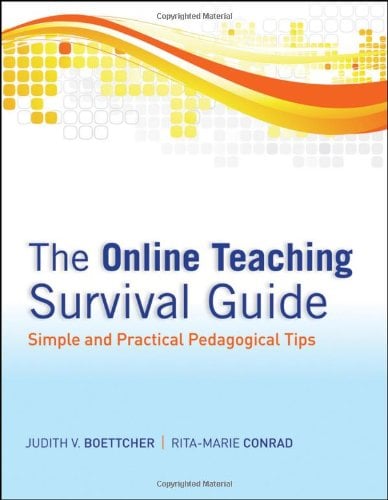What Makes a High Quality Online Course?
What is Online Education?
"Let’s face it: there are a lot of low-quality, low-learning, boring online classes out there," writes distance learning expert Jamie Littlefield. "But, there are also some spectacular online courses that engage students and help them learn in ways that aren’t always possible in a traditional classroom. Most of these top-notch online classes tend to share some traits in common."
Why is online education so important?
The Higher Education Opportunity Act (2008), referred to as HEOA, offers a specific definition of "Distance Education" as a course that:
(a) uses one or more technologies to deliver instruction to students who are separated from the instructor, and
(b) supports regular and substantive interaction between the students and the instructor, synchronously and asynchronously.
Thus, according to the HEOA definition, fully online courses come under the umbrella of distance education.

What Makes Online Teaching Different?
How does a fully online course differ from other courses that use the Internet to deliver course content? Below is a description of the three main types of courses taught on college campuses, from Boise State University:
Web-Enhanced. The majority of on-campus courses at Boise State fall into this category. In a web-enhanced course, the instructor uses a course management system such as Blackboard to post the syllabus and other course material such as excerpts, handouts, or video clips.
Hybrid. The key difference between Web-enhanced and hybrid courses is that the hybrid courses have online elements that replace "seat time" in the traditional classroom. Hybrid (or blended) courses include online interactions and activities.
Fully Online. In this seminar, you’ll be designing and developing a fully online course. In a fully online course, everything that would normally take place in a face-to-face learning environment happens instead via instructional and informational technologies. All student-to-content, student-to-student, and student-to-instructor interactions occur online.
Engagement and Interaction
Moore & Kearsley (1996) posited that an effective online course has three types of interaction throughout:
Learner-Content Interaction: Students are actively engaged in exploring and making sense of course content. For instance, content in the form of reading material, slide presentations or video lectures is paired with active learning strategies such as assignment or discussion questions, comprehension quiz questions or a reflection question posted in a private learning journal.
Learner-Instructor Interaction: Students are given regular substantive opportunities to interact with you, the instructor. For instance, you might give feedback on a paper or assignment, as well as encourage students to ask questions via email or live chat.
Learner-Learner Interaction: Students are encouraged to collaborate and communicate with each other. For example, you might require students to reflect on each other's posts in the discussion board, review each other's work or place learners into groups for short- or long-term projects.
Ideally, your course will include not just rich content, but also multiple opportunities for students to do something with that content. They will explore it, share ideas about their learning with each other, and engage with you for guidance and feedback.
Quality Benchmarks
While there are many ways to promotes best practice in online course design, I emphasize the best practices and standards that are included in the Quality Matters™ Rubric Standards (Fifth Edition, 2014).
Quality Matters (QM) is a nationally recognized program that helps faculty design and develop high quality online courses. QM offers a number of tools that you may use to develop, maintain, and review your online course. Chief among these tools is the Quality Matters Rubric--a set of 43 specific standards used to evaluate the design of online courses.
These standards are related to course overview and introduction; learning objectives (competencies); assessment and measurement instructional materials; course activities and learner interaction; course technology; and learner support accessibility and usability.
A Sense of Community
According to the department of eLearning at Boise State University, a sense of community grows within an online course as students help one another achieve common goals. Student achievement increases significantly when students work collaboratively (Hattie, 2012). This collaboration may occur through activities involving group work, group discussions, collaborative blogs, or group wikis. An online learning community focuses less on socializing and more on helping one another achieve the course learning objectives.
Accessible and Usable For Students With Special Needs
Persons with disabilities should be able to access and use all of the course content, work with other students, and interact with the instructor. Federal civil rights statutes--including Section 504 of the Rehabilitation Act of 1973, and the applicable provisions of the Americans with Disabilities Act of 1990--require schools to build courses that will allow accommodations to be made for students with disabilities.
Most school districts, colleges and universities echoe this requirement. Accessibility and usability of course content is also one of the eight standards of the Quality Matters rubric that we apply to each of the online courses developed through the eCampus Center. Designing accessible and usable online courses does take some extra effort, but you will find that doing so not only improves the course for students with disabilities, it improves the course for all students.
Easy To Navigate
Build your online course as a series of weekly modules. Faculty that use Blackboad with their web-enhanced courses will often put readings in one folder, assignments in another, assessments in a third, and so on. We have found that this organization does not work very well for fully online courses. Instead, I encourage you to create modules in which all of the coursework for one week is organized sequentially in its own area. This lets students know what they need to do and the order in which they need to do it.
Collaborate With Other Faculty
While the characteristics listed above are not the only important facets of a high-quality course, they are key design considerations that will drive much of the design of your course.
Engage, collaborate with and work with other faculty who can provide you with more information. Also, many schools have an instructional design consultants who can suggest ways to design your course to reflect best practices. With these characteristics in mind, you are now ready to proceed with the design of a high quality online instructional program.
References
Allen, I. E., & Seaman, J. (2013). Changing course: Ten years of tracking online education in the United States. Babson Survey Research Group.Retrieved from http://www.onlinelearningsurvey.com/reports/changingcourse.pdf
Culatta, R. (Producer). (2009, October 13). Designing online learning. [Video file] Retrieved from http://www.youtube.com/watch?v=Zv-_GCFdLdo
Hattie, J. (2009). Visible learning: A Synthesis of Over 800 Meta-Analyses Related to Achievement. New York: Routledge
Hattie, J. (2012).Visible Learning for Teachers: Maximizing Impact on Learning. New York: Routledge.
Kumar, D.D. (1991). A meta-analysis of the relationship between science instruction and student engagement. Educational Review, 43(1), 49-61.
Moore, M.G. & Kearsley, G. (1996). Distance Education: A Systems View. Belmont, CA: Wadsworth Publishing Company.
Scholz, C. (Producer). (2011, February 19). Interactions in e-Learning: From theory to practice. [Video file] Retrieved from http://youtu.be/1fAn-Un3Lys








